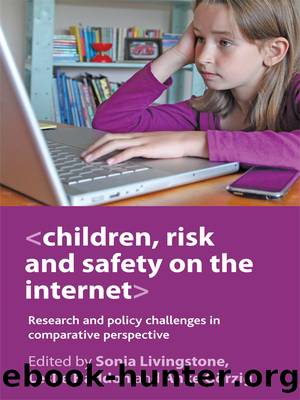Children, Risk and Safety on the Internet by Livingstone Sonia Haddon Leslie

Author:Livingstone, Sonia, Haddon, Leslie [Livingstone, Sonia, Haddon, Leslie]
Language: eng
Format: epub
ISBN: 9781847428820
Barnesnoble:
Publisher: Bristol University Press
Published: 2012-10-01T00:00:00+00:00
General theoretical models
Among the general theories, a ârich get richerâ model of online communication (Bonebrake, 2002; Kraut et al, 2002; McKenna et al, 2002) considers the practice of contacting strangers online to be a consequence of a more general pattern of very intense communication. Indicators, such as the number of online contacts, frequency of internet use and extraversion, can be related to communicating with a more diverse range of people, a number of whom may be strangers.
Conversely, the social compensation hypothesis (Tsao, 1996; Livingstone and Helsper, 2007, p 9; Peter and Valkenburg, 2007) is that socially isolated adolescents try to compensate for an unsatisfactory offline social life through online communications, which will inevitably involve communication and contact with strangers. Measures of emotional and peer problems are suitable indicators to explore this relationship. The rehearsal hypothesis (Peter and Valkenburg, 2011) is a corollary to the compensation hypothesis and states that children with high levels of social anxiety might use the online environment to ârehearseâ online later face-to-face encounters with others.
Another plausible framework is the usage paradigm, which connects internet use with online opportunities and risks (Livingstone and Haddon, 2009, p 17; de Haan, 2009, p 188). A âmore opportunities, more risksâ approach (Livingstone and Helsper, 2010; Livingstone et al, 2011, p 7) implies that the more children use the internet, the more they learn to reap its benefits and deal in a healthy and non-harmful way with potential risks.
A general explanatory model might be the risk migration hypothesis. Since children encounter different degrees of risk, those who encounter more risks in their daily (offline) lives tend also to encounter more risks in their online lives (Livingstone and Görzig, 2011, submitted). However, risk does not always result in harm; and risk-taking can be beneficial in terms of building resilience (Masten et al, 1990).
Explanations related to harm include a general vulnerability hypothesis (see Livingstone and Görzigâs chapter in this volume), in which psychological difficulties and demographic factors are important predictors of harm from exposure to the risk of meeting offline someone originally met only online. In addition, lack of self-efficacy, conceptualised as a measure of personal agency and degree of locus of control (Schwarzer et al, 1999), has been found to be associated with more and wider internet usage (Eastin and LaRose, 2000) and more online risks (Livingstone and Helsper, 2010).
Finally, the adolescentâs desire for autonomy and independence from parental authority (Elder, 1963) might play an important role in childrenâs online and offline activities, notably in establishing and expanding their social circles.
Download
This site does not store any files on its server. We only index and link to content provided by other sites. Please contact the content providers to delete copyright contents if any and email us, we'll remove relevant links or contents immediately.
Cecilia; Or, Memoirs of an Heiress — Volume 1 by Fanny Burney(32374)
Cecilia; Or, Memoirs of an Heiress — Volume 3 by Fanny Burney(31749)
Cecilia; Or, Memoirs of an Heiress — Volume 2 by Fanny Burney(31715)
The Great Music City by Andrea Baker(31086)
We're Going to Need More Wine by Gabrielle Union(18905)
All the Missing Girls by Megan Miranda(15391)
Pimp by Iceberg Slim(14212)
Bombshells: Glamour Girls of a Lifetime by Sullivan Steve(13927)
Talking to Strangers by Malcolm Gladwell(13131)
Norse Mythology by Gaiman Neil(13125)
Fifty Shades Freed by E L James(13120)
For the Love of Europe by Rick Steves(12342)
Crazy Rich Asians by Kevin Kwan(9123)
Mindhunter: Inside the FBI's Elite Serial Crime Unit by John E. Douglas & Mark Olshaker(9103)
The Lost Art of Listening by Michael P. Nichols(7359)
Enlightenment Now: The Case for Reason, Science, Humanism, and Progress by Steven Pinker(7084)
The Four Agreements by Don Miguel Ruiz(6541)
Bad Blood by John Carreyrou(6476)
Weapons of Math Destruction by Cathy O'Neil(6084)
